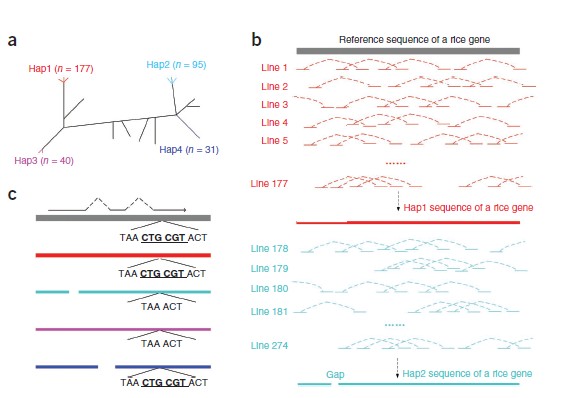Genome-wide Association Study Identify Alleles Controlling Important Agricultural Traits Directly in Rice
Rice is an important crop among the world and feed nearly 50% world population. Rice is planted widely and many rice cultivars have excellent agricultural traits, which are the resources for rice improvement. How to identify and make use of the genes that control the excellent agricultural traits with high efficiency is a challenge to rice researchers and rice breeders. Recently, professor HAN Bin’s group in National Center for Gene Research (NCGR), Chinese Academy of Sciences (CAS) and Beijing Institute of Genomics (BIG), CAS, applied genome-wide association study (GWAS) and identified alleles controlling important agricultural traits directly in rice, instead of classical biparental cross-mapping method for dissecting complex traits.
Last year, HAN’s group performed the low-coverage sequencing of 517 Chinese rice cultivars and developed GWAS analysis in the indica population for the first time and identified some alleles controlling 14 agricultural traits. Based on the previous researches, they collected more rice cultivars from China and other countries and extended the rice population to 950, which include the rice accessions from 34 countries. The broader sampling greatly enhanced the power of the GWAS. Then they sequenced these samples and developed a framework for haplotype-based de novo assembly. Also they collected phenotype data of such important agricultural traits as flowering time (heading date) and grain-related traits and used them for GWAS analysis in the rice population, including indica and japonica subpopulations and the full population.
To characterize various alleles and functional genetic variation, researchers integrated the data of gene annotation, the data of gene expression profile and the data of sequence polymorphisms and identify the genes that control the corresponding agricultural traits with more accuracy. As a result, in addition to the loci identified previously, they identified 32 new loci underlying flowering time and ten grain-related traits.
This study shows that the integrated approach of sequence-based GWAS and functional genome annotation has the potential to match complex traits to their causal polymorphisms in rice. The article is accepted and published online by Nature Genetics on Nov 2, 2011.
Paper link: http://www.nature.com/ng/journal/vaop/ncurrent/full/ng.1018.html

Illustration of haplotype-based local assembly (Image by HAN’s group)